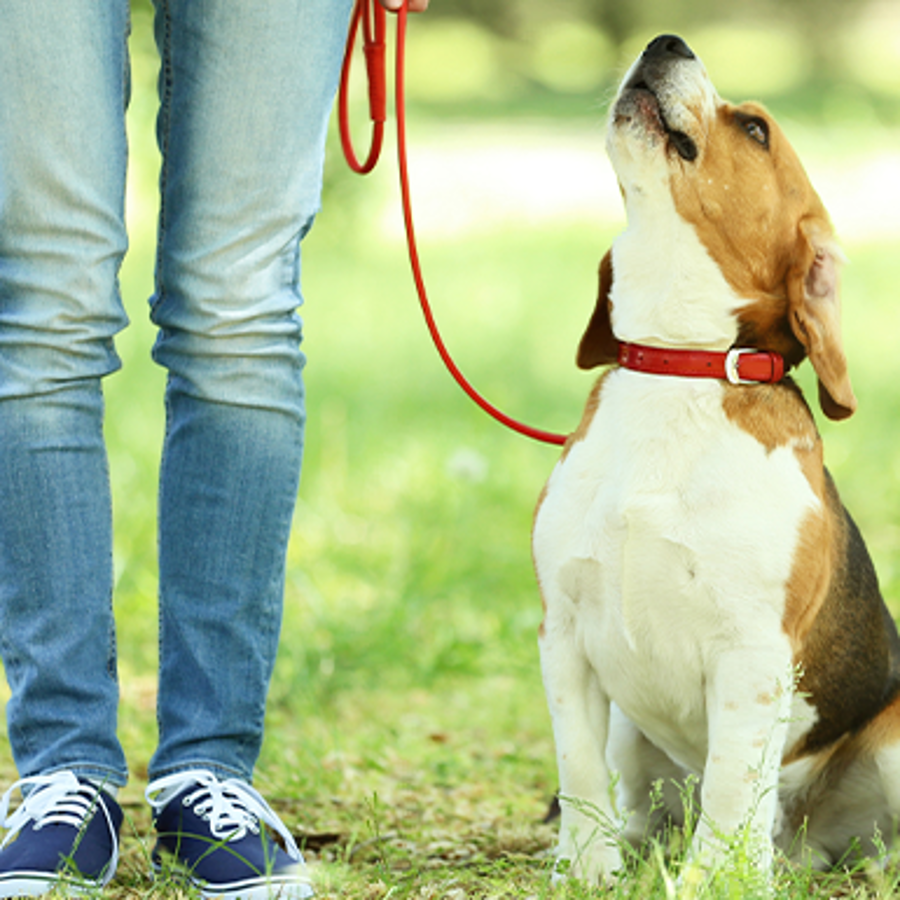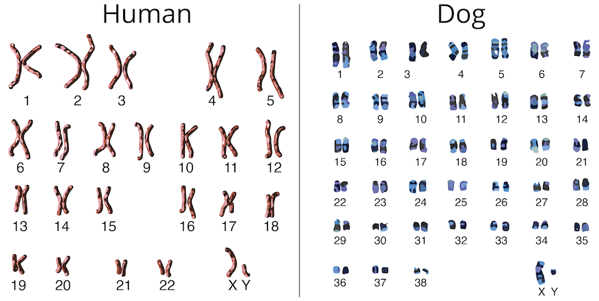
Do dogs have the same kind of DNA as humans?
September 12, 2012

- Related Topics:
- Comparing species,
- Genomics,
- Evolution
An elementary school student from California asks:
"Do dogs have the same kind of DNA as humans?"
Yes and no. Yes their DNA, like every living thing’s DNA, is made of the same building blocks of A’s, T’s, G’s, and C’s. But their DNA isn’t exactly alike. All those A’s, T’s, G’s, and C’s are put together in different orders for dogs and people.
In fact, even though you and I both have human DNA, our DNA is put together a little differently too. Which all makes sense when you think about DNA (DeoxyriboNucleic Acid) as a cookbook for building a living thing.
The recipes in this DNA cookbook are written in a simple language with only the four letters A, T, G, and C as its alphabet. Doesn’t sound like enough letters but they are plenty because there are billions of them repeated and jumbled in so many different combinations. Which means that the DNA inside of you or a dog is really, really long.
A complete set of human DNA has a total of 3.3 billion letters. If these were printed on a giant piece of paper, with 50 letters per square inch, the piece of paper you’ll need would be 8 times the size of a football field!
You are different from me because every now and then, you have a different letter from me at a certain spot. So maybe at position #17,456,327 I have an A and you have a G.
On average, you and I have around six million of these differences. And you and a dog have many more differences within and outside of your recipes.
Different Cookbooks, Different Organisms
As I said, your complete set of DNA or genome can be thought of as the book that carries all the instructions for making you. As we’ve learned, as a human you have around 3.3 billion letters. A dog’s is a bit smaller with only 2.8 billion letters.
These 500 million different letters sounds like a big deal but it turns out they probably aren’t. Most of these are more like blank pages or maybe doodles in the book. Losing them probably isn’t the big difference between dogs and people.
As you can also see in the picture below, humans and dogs have different numbers of chromosomes too. But the number of chromosomes doesn’t really matter much either.

Just as a book is divided into chapters, and chapters into sentences, the long strings of genome DNA are chopped up into “chapters” called chromosomes. Within each chromosome are pieces called genes with an average length of 3,000 letters.
Genes are like the individual recipes in a cookbook. Instead of recipes for cookies or spaghetti sauce, these are recipes for hair color, making eyes or putting our brains together. Like in a real cookbook, the recipes have the differences that matter.
If you took a cookbook and just divided it up differently, it wouldn’t matter. All the recipes would still be there. This would be like dividing someone’s genes into a different number of chromosomes. It wouldn’t matter either.
But if you put together a book of different recipes, then you’d have different cookbooks and so make different meals. This is one of the big differences between people’s and dog’s DNA.
Now the difference between people and dogs isn’t the number of recipes. Humans and dogs have about the same number of genes, about 20,000 or so. A human’s genes are split across 23 chromosomes while dogs have around the same number spread across 39 chromosomes. In a sense, humans and dogs have cookbooks filled with the same number of recipes.
This makes sense, because humans and dogs share so many similar body parts that carry out the same basic biological functions. They even share many kinds of genetic diseases - cancer, blindness, and congenital heart disease, for example. That’s why scientists have been turning to dogs as a model for studying human diseases.
The differences between you and Lassie (Toto? Snoopy?) have more to do with having a few different recipes and with changes within the ones you share. You also have differences in the instructions for how often and when each recipe is read compared to a dog.
So you might have a crème brulee recipe that the dog’s cookbook doesn’t have. Or a dog might have a recipe for oatmeal raisin cookies, while you have one for oatmeal chocolate chip cookies instead. All these kinds of differences make you different from a dog (and to a lesser extent, different from me).

Most of these differences are the result of having different letters in the recipes themselves or in the instructions in how to use them. In other words, some differences are in the genes themselves and some are in the DNA outside of the genes that tell a cell how often to read a gene.
There's a lot of different ways to compare how similar two species are, so you'll see different numbers for how much DNA dogs and humans share. But the group that first sequenced the dog genome found that they could match up about 73% of dog DNA to human DNA. And they found that almost all of a dog's genes are also found in humans.
On the whole, when the tiny changes are piled up across 20,000 genes and across trillions of cells in the body, the results are two very different organisms.

Author: Widya Mulyasasmita
When this answer was published in 2012, Widya was a Ph.D. candidate in the Department of Bioengineering, studying regenerative medicine and protein engineering in Sarah Heilshorn's laboratory. Widya wrote this answer while participating in the Stanford at The Tech program.
 Skip Navigation
Skip Navigation
